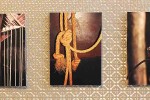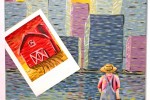
KEARNEY – Four art majors at the University of Nebraska at Kearney will have their senior projects displayed through Nov. 21 in the Walker Art Gallery inside the Fine Arts Building.
The Art Education Senior Exhibition features the work of James Beavers, Blue Hill; Elizabeth Bloomfield, Minden; Tara Powell, McCook; and Kara Trampe of Amherst. They will host a reception from 2 to 4 p.m. Nov. 9 as part of the exhibition.
The Walker Art Gallery is open from 8:30 a.m. to 4:30 p.m. Monday through Friday.
Information about the artists and their projects:
JAMES BEAVERS

Medium – Bronze, ceramic
Exhibition Statement – Throughout the process of building my senior show, I began to realize that the connection between my pieces was a story of how I have grown as a person and as an artist. My pieces portray a resilient effort to refine my techniques, just as I have proceeded to build confidence in myself. Often, I envision a plan of what I want my pieces to look like and as usual I prove to myself that everything is not in my control. In my work I see the growth of learning to embrace this idea. The pieces of my show evolved into something more beautiful than I had originally planned. After discovering what I call unintentional beauty, I then proceed to repeat the process to find new ways of expressing this unique inspiration.
Before I envision what my artwork will look like I use influences from my personal experiences that stem from the teachers I have had to the places I have been. I use texture, form and contrast to provide a foundation that solidifies my experiences to my artwork. My artwork is part of a process that makes me a better artist and a better person. The process of overcoming obstacles has taught me patience, confidence and different perspectives on life.
ELIZABETH BLOOMFIELD

Medium – Digital Photography
Title of Works – Mechanism of Change
TARA POWELL
Medium – Acrylic, ceramic
Exhibition Statement – This exhibit draws from several different ideas. The use of Polaroid pictures to represent the past is the foundation in which this show was developed. The present is represented, while the past is presented in the Polaroid picture suspending from thin air, giving it a whimsical dreamlike feeling.
The overarching theme is love. Everyone can relate to having loved someone or something. Loving something leaves you vulnerable for when it becomes lost. Nothing lasts forever so everything must come to an end, but the love remains. It makes the paintings personal and something that everyone can attest to having experienced.

Faces are never shown. This allows the viewers to visualize themselves within the paintings. When you paint a face, you cannot change who is represented in the art, but by showing the back of the head, anyone can put their own face in the painting. The audience can therefore connect to the art on a more deep and meaningful level.
Color is used in a bold way. This makes the paintings pop out. The use of color can help stimulate a certain mood. The bold colors lighten the mood of the more sad paintings without destroying the stories behind them.
Short noticeable brush strokes are a commonality within all of my paintings. It gives the works of art more of an artistic appearance. There is enough detail in the paintings to get the point across, but not enough to ruin the imagination of the audience. Doing this forces the audience to fill in the gaps and, in a way, paint their own picture by visualizing the missing details in their minds.
The goal of this exhibition was to create artwork that people get lost in – something that they can somehow relate to, possibly without ever experiencing the exact scenario that is represented in the piece. The show was derived from the idea of stimulating their emotional side, as well as get them thinking about the paintings on a higher level than just visually.
KARA TRAMPE

Title of Works – “Portrait Studies using marker and watercolors”
Exhibition Statement – People are immediately judged by their physical appearance, positively or negatively. However, what most people want is for everyone to know who he or she is on the inside. People go to great lengths trying to express themselves through many different mediums in hopes of affecting other’s interpretations of who they are. Without consent it happens on a daily occurrence that one is being judged by what they look like on the outside. Everyone should work to see others for who they are on the inside, and not be so quick to judge each other by ones skin color, height, weight or gender.
The goal for one set of these works is to introduce individuals by bringing what is on the inside, out. Taking away the subjects’ facial features puts the focus on the colorful beauty that is within them. Not taking too much focus away from their physical representation, one is still identifiable, but it is kept in black contour lines to keep the emphasis on.
The other set of works is a series of character studies that are wholly made up of black lines. They are kept simple, but still have an element of complexity to them. Each character tells his or her own story and leaves the interpretation up to the viewer. This takes away the ability to see what is on the inside, but the characters’ positioning and expressions shed light on who they are as a person.
Identity should not be limited to describing his or her physical characteristics. It should encompass all attributes that make up a person.
-30-
Contact: John Fronczak, 865.8084, fronczakje1@unk.edu














VERY nice art! Thank you for the share!